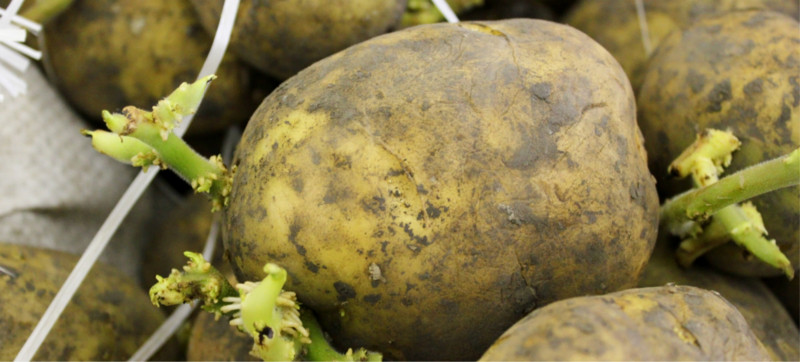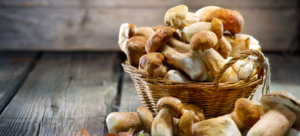How To Grow Potatoes Indoors – The Ultimate Guide

Are you interested in growing potatoes? Do you have old potatoes growing in your cupboard? Do you want to know how to grow potatoes indoors?
Potatoes make up some of our favorite foods like mashed potatoes, french fries, and potato salad. They’re used across the world not only because of how versatile they are to cook with, but how easy they are to grow.
Have you ever wondered how you can grow them in your backyard? Did you know you can grow potatoes inside your house? Let’s dive into the potato-growing world!
How to Grow Potatoes Indoors
Like growing any plant outside, you have to be mindful of the season. Potatoes grow best in cool weather. Start planting about 2-4 weeks before the last frost in the early spring. The soil temperature should be at least 40 degrees F.
The beauty of growing potatoes indoors is you don’t have to be as critical about the weather, as you control the ambient temperature. This means it’s possible for you to have potatoes year round!
Step 1: Pick the Right Potato
First you’ll need some “seed potatoes“. These are not the actual seeds, but the “eyes” of sprouting potatoes. I’m sure you’re wondering how to plant potatoes from eyes, let’s find out!
You can find seed potatoes in garden stores or use old potatoes from your kitchen that have started sprouting. There are several varieties of potatoes, some better than others for growing yourself. We’ll go over those in detail further down.
Step 2: Preparing Your “Seeds”
Cut your seed potatoes into chunks. Each piece should have at least 1-2 eyes. Let the pieces sit for a day or two. This helps the cuts dry and reduces the risk of rotting once they’re in the ground.
Some people will plant these “seeds” directly into the soil, with a very heavy initial soak and enough heat/sunlight the plants will take off like weeds. This is the easiest way to do it, especially when growing outdoors.
Growing potatoes in a container, indoors or outdoors, can be a little more tricky. Generally it’s best to get some root growth prior to putting them in their containers.
This can be achieved by allowing about half of your potato to sit submerged in a glass of water. Don’t submerge it entirely though, and make sure you’re only submerging the cut end of your potato. Prop it up with toothpicks or a couple forks to prevent your potato from falling all the way in.
Make sure your potato gets at least 5-6 hours of sunlight a day, and when you start to see roots, it’s time to plant!
Step 3: Choose the Perfect Container
Find a container that’s at least 12-15 inches deep, preferably about 2.5 gallons in volume. It should have good drainage holes so water doesn’t sit at the bottom. Be sure to thoroughly wash your pot before planting to prevent any possible contamination.
Step 4: How To Grow Potatoes In A Container
Place about 4 inches of potting soil in the bottom of your container. Put 2-3 seed potatoes in the soil with the eyes facing up and cover them with an additional 3 inches of soil. Generally you want about a 6 inch distance between each potato start.
As they grow, you’ll mound more soil around the plants. This is called “hilling”, and it helps grow more potatoes. Potato plants need sunlight on the leaves, but not on the potatoes themselves.
Make sure your container is next to a window that gets plenty of sunlight! If you are trying to grow your potatoes indoors and leave them in a dark room, you’re not going to have any luck.
Step 5: Care and Watering
Potatoes love water, but not too much! Keep the soil moist, but not soggy. Water them early in the day so the leaves have time to dry before nighttime. The soil should be about as wet as a sponge that’s been wrung out.
Step 6: Time to Harvest
In about 10-12 weeks, your plants will start to flower. You can easily dig around the edges of a plant to grab a few ‘new potatoes’ as the flowers die. If you want bigger potatoes, wait a few more weeks. Once the plant turns yellow and dies back, your potatoes are ready for a full harvest. Dig them up and enjoy!
They can stay underground once the plant dies for up to 2 weeks, and once harvested, if stored properly, can last for up to 5 months! Just be sure they’re stored in a dark, cool, dry place.
Tips for container growing:
- Always water in the morning.
- Turn the container every few days so every part of the plant gets light.
- Be patient. Growing food takes time, but it’s worth it!
Best Types of Potatoes to Grow Yourself:
Russet Potatoes: Classic brown-skinned, white-fleshed potatoes most commonly found in grocery stores. These are versatile for cooking and are a good choice for beginners because they are hardy and adapt well to different conditions.
Red Potatoes: Known for their red skin and white inside, these potatoes are generally easy to grow and are less susceptible to certain pests.
Yukon Gold: A favorite among many gardeners, Yukon Gold potatoes have a yellow flesh and are known for their delicious taste and texture. They’re also resistant to some common potato diseases.
Fingerlings: These are small, elongated potatoes that are often gourmet choices in restaurants. They grow well and are typically less troubled by pests.
Why Are These Potato Types Easy To Grow?
Adaptability: These potatoes are known to thrive in various soil conditions, making them easy for most gardens.
Disease Resistance: Certain potato types, like Yukon Gold, have been bred to resist common potato diseases. That’s one less thing for you to worry about starting out!
Short Growth Cycle: Some potatoes mature faster than others. Varieties like the early-season red potatoes can be harvested sooner, which is especially beneficial in regions with shorter growing seasons.
Best Growing Medium for Potatoes
Well-Draining Soil: This is the biggest factor. Potatoes can rot if they sit in soggy waterlogged soil. A sandy-loam soil is perfect because it holds enough moisture while allowing excess water to drain away.
Compost: Adding compost into your soil not only enriches it with nutrients but also improves its texture. This makes it easier for potato tubers to grow and expand.
pH Level: Potatoes prefer slightly acidic soil with a pH of 5.0 to 6.0. If your soil is too alkaline, you can add some sulfur to lower the pH.
Avoid Fresh Manure: While manure can be a great soil amendment for many plants, fresh manure can increase the risk of potato scab. If you want to use manure, make sure it’s very decomposed or aged.
Potting Soil (for Container Growing): If you’re growing potatoes in containers or bags, it’s usually best to use a premium potting soil full of organic matter. These mixes are crafted to retain moisture while providing good drainage. They’re also usually free from soil-borne diseases from the bag.
Growing potatoes is a fun adventure anyone can enjoy. Whether you have a spacious garden or a balcony or even a good spot inside, potatoes can be a part of your gardening journey.
Remember to give them water, sunlight, and a bit of care, and you’ll soon enjoy the delicious reward of your hard work. Now you know how to grow potatoes indoors!
Have questions about your grow? We're Here To Help!
Our Northern California based experts can help. We're here to make sure you get what you need to maximize your harvest.





